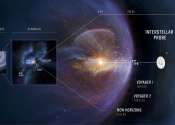Time is running out to add your name to NASA's Europa Clipper
Six weeks remain for you to add your name to a microchip that will ride aboard the spacecraft as it explores Jupiter's moon Europa.

Six weeks remain for you to add your name to a microchip that will ride aboard the spacecraft as it explores Jupiter's moon Europa.
Astronomy
Nov 13, 2023
1
108

(Phys.org) -- Two of three key signs of changes expected to occur at the boundary of interstellar space have changed faster than at any other time in the last seven years, according to new data from NASA's Voyager 1 spacecraft. ...
Space Exploration
Aug 3, 2012
14
0

For the 30th anniversary of one of the most iconic views from the Voyager mission, NASA's Jet Propulsion Laboratory in Pasadena, California, is publishing a new version of the image known as the "Pale Blue Dot."
Space Exploration
Feb 13, 2020
4
868

Jupiter's moon Ganymede is the largest planetary satellite in the solar system. It's also one of the most intriguing: Ganymede is the only moon with its own magnetic field, it is the most differentiated of all moons, and ...
Space Exploration
Jan 21, 2021
1
662

NASA announced the winner Tuesday of a contest to send a message to the Voyager spacecraft which launched 40 years ago on a historic mission to explore the outer planets.
Space Exploration
Sep 5, 2017
7
962

(Phys.org) —Data from NASA's Voyager 1 spacecraft continues to provide new insight on the outskirts of our solar system, a frontier thought to be the last that Voyager will cross before becoming the first man-made object ...
Space Exploration
Jun 27, 2013
25
0

(PhysOrg.com) -- Scientists analyzing recent data from NASA's Voyager and Cassini spacecraft have calculated that Voyager 1 could cross over into the frontier of interstellar space at any time and much earlier than previously ...
Space Exploration
Jun 15, 2011
13
3

The heliosphere—made of solar wind, solar transients, and the interplanetary magnetic field—acts as our solar system's personal shield, protecting the planets from galactic cosmic rays. These extremely energetic particles ...
Astronomy
Mar 29, 2024
6
1007

(PhysOrg.com) -- The 33-year odyssey of NASA's Voyager 1 spacecraft has reached a distant point at the edge of our solar system where there is no outward motion of solar wind.
Space Exploration
Dec 13, 2010
33
2

The Voyager spacecraft are now in the outermost layer of the heliosphere, traveling toward interstellar space - the first man-made spacecraft to travel such a vast distance from Earth.
Space Exploration
Nov 10, 2009
2
0